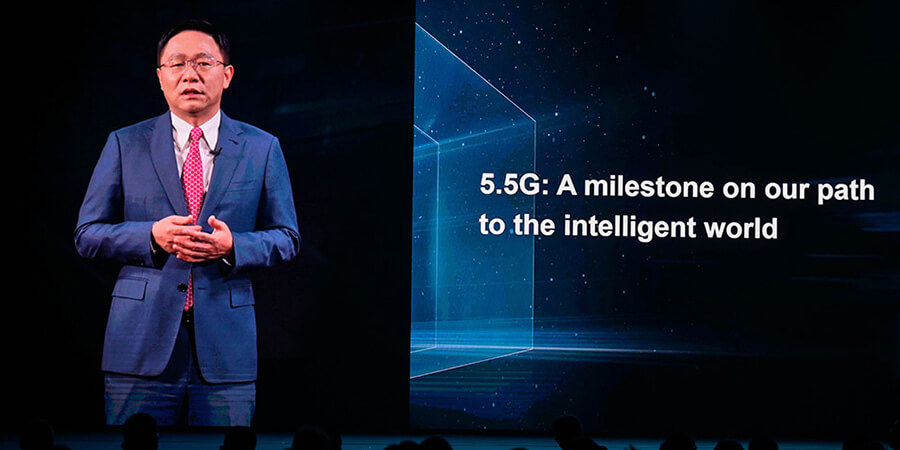Ubiquitous 10 Gbit/s experiences, the number of connected IoT devices reaching hundreds of billions, energy efficiency, and everything around will become intelligently connected, including wearables, intelligent vehicles and robots —these are what will be shaping the 5.5G era.
On the second day of Huawei’s Mobile Broadband Forum 2022, David Wang, Huawei's Executive Director of the Board and Chairman of ICT Infrastructure Managing Board, shared a glimpse of what the future with 5.5G will be.
“And now a fully connected intelligent world is fast approaching. In this world, everything will be possible and the rapid changes we are about to experience will be accompanied by increasing requirement for digital infrastructure,” Wang said.
He said that 5G has become a pillar of global digitalization and serves as a milestone on the road to the intelligent world.
Through a common vision and collaborative efforts, Wang said the industry has made great strides and is now geared towards 5.5G. He urged all industry players to continue working together and be more ready to propel forward to the 5.5G era and eventually build a better, intelligent world together.
This latest breakthrough is expected to generate market potentials and open opportunities, despite the challenges in the next five years, including highly diverse and very demanding requirements. And amid all these, Huawei continues to evolve to lead the 5.5G era.
For individuals, immersive services like XR and holographic communication are constantly becoming more sophisticated, with 10 gigabyte per second services to bridge both time and space. In industry, digital technology will continue to reshape production with intelligence becoming central to almost every industry. This will need to support over 1 gigabyte per second uplink rates, lower latency and higher reliability.
“Since 2020, we have worked with our industry partners to define a vision for 5.5G. After 2 years of hard work, we have achieved a lot and three things have become clear,” Wang said. He
Wang stressed that 5.5G has made remarkable progress and proved three things.
One of them is shifting the 5.5G concept into reality, which is now on course to fully develop its potential as its standardization has also been initialized.
Second, even more advanced key technologies for 5.5G have been developed, and ultra-large bandwidth and ELAA can now deliver 10 Gbit/s experience.
Wang also said that the industry now has a better glimpse of the IoT landscape. He specified the three types of 5.5G-enabled IoT technologies supported by 5.5G. These are: NB-IoT, RedCap, and passive IoT, which are all growing fast and will support numerous IoT connections.
Five steps to reach the 5.5G milestone
As Huawei constantly innovate standards, technology and the industry as a whole, it is now well-equipped to jump on to 5.5G. Wang pointed out the five steps it will need to take to take to realize these goals. “5.5G has been kicked into high gear. Looking ahead, our task is to tackle these five new areas – standards, spectrum, products, ecosystems, and applications.”
Wang suggests the need to set standards and support key technological research. “Standards will steer the mobile communications industry and will guide the 5.5G industry forward alone are clearly defined path. Work on release 18 is already underway to further enhance the eMBB, we need to verify key technologies and ensure 5.5G increases natural performance by 10 times.”
Wang added that key industry milestone must be aligned to ensure release 18 is frozen by the first quarter 2024, its expected timeframe.
Achieving the full capabilities in 5.5G also requires new spectrum considerations and that is what Huawei is also focusing on. Wang explained, “Wide spectrum will be foundation for the 5.5 G technology innovation and capability delivery, millimeter wave is one of the key frequency band for the 5.5 G. Operators will need to take steps to acquire over 800 MHz of spectrum to realize millisecond level latency and become forerunners in this area. 6 gigahertz, on the other hand, is also a potential ultra wide band for the 5.5G.”
The successful commercialization of 5.5G will be closer to reality if more operators and equipment, device and chip vendors would also move along together with Huawei. They would need to begin testing technological solutions and system networking to ensure that interoperability device testing can be completed by 2024.
Wang has also put emphasis on the need for a collaboration to build a thriving 5.5G ecosystem to fulfill these requirements. He foresees that in the future, a single network will be able to support hundreds of billions of connections, including connections between people and things. And device vendors should be ready to adapt the costs and modular capabilities to application scenarios.
And amid the emergence of new generation of innovative applications, Huawei has developed a clearer vision of the intelligent world. Wang suggested that all industrial players should now work together, to explore and create these applications. He encourages all their ecosystem partners, “Together, let's stride to 5.5G and build a better intelligent world.”





